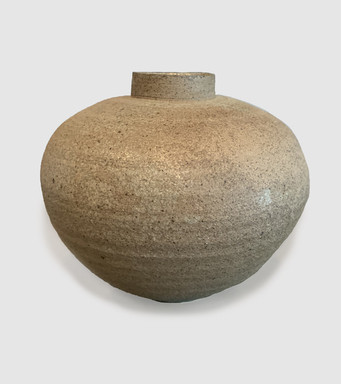
Artist:Kamoda Shoji
Medium: Ash glazed stoneware
Geograhical Locations:
Dates:ca. 1967–1968
Dimensions: 7 7/8 × 8 1/4 in. (20 × 21 cm)
Collections:
Accession Number: 2020.1.5
Image: CUR.2020.1.5_side_edited.jpg,
Catalogue Description: Round jar, small at the base and flaring to broad shoulders, with a narrow straight neck ending in a sharply finished rim. Slight ridges are visible on exterior from finishing on a wheel. Entire vessel is covered in a slightly mottled gray ash glaze with subtle tones of green and brown. With this jar the artist is experimenting with a revival of past techniques and forms. This type of vessel is called a Heian Tsubo (flower vessel) in reference to the historic name for Kyoto, Heian, and the Heian period (794-1185), when ash-glazed stoneware jars in similar forms were made. The materials and rounded base of this jar also has strong associations with Korean stonewares of the Three Kingdoms and Unified Silla periods. Kamoda Shoji was a ground-breaking ceramicist who worked in many different modes. Cited by many to be the most important Japanese ceramicist of the twentieth century, his brief career has been celebrated in several one-man retrospectives in Japan. Accompanied by a traditional wood storage box with artist's signature and seal.